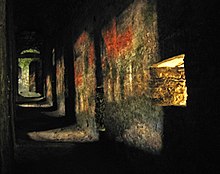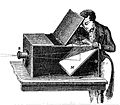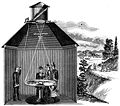Camera obscura
![]()
The articles camera obscura and pinhole camera overlap thematically. Information that you are looking for here may also be found in the other article.
You are welcome to participate in the relevant redundancy discussion or to help directly to merge the articles or to better distinguish them
from each other (→ instructions).
![]()
The title of this article is ambiguous. For other meanings, see Camera obscura (disambiguation).
A camera obscura (lat. camera "chamber"; obscura "dark") is a dark room with a hole in the wall, used as a metaphor for human perception and for the production of images. If the dark room is the size of a box, it is also called a pinhole camera.
While the technical principles of the pinhole camera were already known in antiquity, the use of the technical concept to produce images with a linear perspective in paintings, drawings, maps, architectural realizations, and later also photographs was not applied until the (or, cf. Erwin Panofsky, the) Renaissance(s) of European art and the scientific revolution of the modern era. Among others, Leonardo da Vinci used the camera obscura as a likeness of the eye, René Descartes for the interplay of eye and consciousness, and John Locke began to use the principle as a metaphor of human consciousness itself. This modern use of the camera obscura as an "epistemic machine" had important implications for the development of scientific thought. Last but not least, Karl Marx's Dialectical Materialism and its famous claim to want to turn the Hegelian dialectic from its head to its feet (cf. The German Ideology 1845-46) uses the optical effect as a central metaphor.

Functionality of a camera obscura

Projection of roofs and treetops opposite a wall with embrasures on a wall in Bellinzona

This type of camera obscura was used as a sketching instrument in the 18th century. With a sheet of paper on the glass pane, the object being viewed could be copied directly.
Structure
A camera obscura consists of a light-tight box or room into which light from an illuminated scene shines through a narrow hole onto the opposite back wall. An upside-down and laterally inverted image of this scene is thereby formed on the back wall. The image is weak in light and can only be seen well if it is sufficiently darkened. If the back wall is transparent, the image can also be viewed from the outside if sufficient darkening is provided, for example by using an opaque cloth that covers the back of the back wall and the viewer's head.
· 
Box-shapedCamera
obscura
· 
Tent-shapedCamera
obscura
· 
Cottage-shapedCamera
obscura
How it works
If light falls through a small hole into an otherwise light-tight hollow body, a side-inverted and upside-down image, a projection of the outside space, is generated in it. The schematic drawing at the top right shows, as an example, two beams of light entering the hole from two points on an object. The small diameter of the aperture restricts the bundles to a small opening angle and prevents the light rays from overlapping completely. Rays from the top of an object fall on the bottom of the projection surface, and rays from the bottom are transmitted upward. Each point of the object is imaged as a slice on the projection surface. The superposition of the slice images creates a distortion-free image. In mathematical terms, the image is the result of a convolution of the ideal image of the object with the aperture surface.
Imaging geometry of a converging lens
If G denotes the object height (= actual size of the observed object), g the object width (= distance of the object from the lens), b the image width (= distance from the pinhole to the focusing screen) and B the image height (= height of the generated image on the focusing screen), the following applies:
(1)
Equation (1) is also known from geometrical optics as the 1st lens equation. For the mathematical derivation, reference is made to the ray theorem in geometry. The image size therefore depends only on the distances, but not on the aperture size or hole size.
Questions and Answers
Q: What is a camera obscura?
A: A camera obscura is a darkened room or box with a small hole or lens through which an image is projected onto a surface opposite the hole.
Q: What is the origin of the term "camera obscura"?
A: "Camera obscura" is derived from the Latin words "camera obscūra," which mean "dark chamber."
Q: How does a camera obscura work?
A: Light passes through the small hole or lens and projects an image onto the opposite surface. The size of the hole affects the sharpness and light-sensitivity of the image.
Q: Is the projected image always upside-down in a camera obscura?
A: Yes, the image is always upside-down in a camera obscura.
Q: How can an artist create a copy of the projected image in a camera obscura?
A: The projection can be made on paper, and an artist can copy the image onto the paper.
Q: Is it possible to project a "right-side-up" image in a camera obscura?
A: Yes, by using mirrors, it is possible to project a "right-side-up" image in a camera obscura.
Q: What is the difference between a camera obscura and a pinhole camera?
A: A camera obscura is a room or box with a small hole or lens that projects an image onto a surface, while a pinhole camera is a small box with a small hole or lens that captures an image on film or digital media.
Search within the encyclopedia
